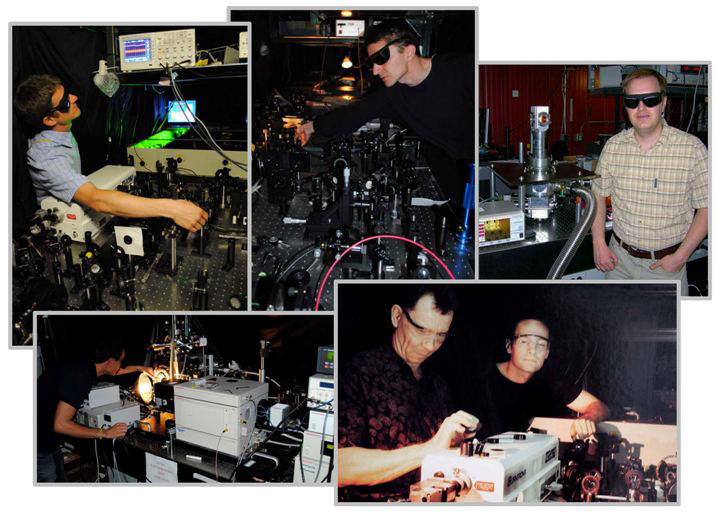Ultrafast Optical Spectroscopy Facilities
Transient absorption spectroscopy
- Spectra-Physics Spitfire setup optimized for infrared spectroscopy
- 1 KHz repetition rate, 1 mJ/pulse, 100 fs pulse width, 800 nm wavelength
- Light Conversion Topas multi-pass OPA, covers wavelengths from 400 nm to 10 µm
- single-pass OPA, covers 1.0 - 2.5 µm spectral range
- detection with Ge, InGaAs, HgCdTe, InSb single point and array detectors
- Clark-MXR CPA-1000 setup optimized for visible spectroscopy
- 1 KHz repetition rate, 0.5 mJ/pulse, 150 fs pulse width
- Clark-MXR Igor OPA, covers 480 nm – 2.2 µm spectral range
- Coherent Reg-A 9000-PW Dual Amplifier laser system optimized for multi-pulse measurements and low-temperature high magnetic field measurements in conjunction with an Oxford Instruments Spectramag 4000-8 magnetic cryostat
- two simultaneous output beams at 6 µJ/pulse and 4 µJ/pulse, maximum repetition rate at 250 KHz, 160 fs pulse width, 800 nm
- two infrared OPAs (Coherent 9800) that can be simultaneously pumped by the single 6 µJ/pulse amplifier output
- one visible OPA (Coherent 9400) that can be pumped by the 4 µJ/pulse amplifier output
- simultaneous generation of 6 different wavelength beams that are in coherence (800nm, 400nm, 266nm, two infrared OPAs, one visible OPA)
- optical scanning for measuring films at low temperatures without radiation damage
- Oxford Instruments Spectramag 4000-8 magnet with optical cryostat for low-temperature and high-magnetic field measurement. Variable magnetic field (0-7T) and temperature (1.7-300K) with large optical window
Ultrafast Photoluminescence Spectroscopy
- Photoluminescence upconversion setup
- Coherent Reg-A 9000 amplified Ti:sapphire femtosecond laser system (independent of the above dual-amplifier), 250 KHz repetition rate, 4 µJ/pulse
- provides sub-picosecond resolution of photoluminescence decay in the 400 nm - 2.5 µm wavelength range using an ultrafast upconverting gate pulse with a controllable delay
- Time-correlated single photon counting in the visible regime
- 30 ps time resolution, 300nm-900nm spectral window for detection
- excitation with 10KHz-250KHz femtosecond pulses from RegA 9000 at 800nm, 400nm, 266nm or tunable excitation with Coherent 9400 OPA 300nm-700nm
- excitation with picosecond high-repetition rate lasers PicoQuant
- Time-correlated multi-channel photon counting in the infrared regime
- 200 ps time resolution, 900nm-1600nm spectral window for detection with Hamamatsu InGaAsP detector
- excitation with 10KHz-250KHz femtosecond pulses from RegA 9000 at 800nm, 400nm, 266nm or tunable excitation with Coherent OPA between 480nm-700nm or 930-2300nm
- excitation with high repetition rate (up to 80 MHz)diode lasers by PicoQuant
- Picosecond time resolution Hamamatsu Streak Camera C5680
- 2 ps time-resolution with simultaneous detection of all wavelengths in the 400 nm - 900 nm spectral range
- several detection modules (synchroscan, single shot, etc.) for measuring dynamics time windows anywhere from 200 ps up to 1 ms
- Superconducting Nanowire Single Photon Detector (SSPD)
- Two channel NbTiN nanowire detector for measuring PL dynamics from ~50 ps to a 65 µs
- Ideal for near-IR time correlated single photon counting (TCSPC) studies or photon correlations studies
- Operates in a closed cycle He cryostat (3-5K) biased near the superconducting critical current
- Sensitive from UV to ~2 µm, very low dark count rate (~300 Hz) with ~5% detector efficiency
For more information on our current optical spectroscopy projects, please visit the Advanced Optical Spectroscopy section of Our Research.
August 2010

